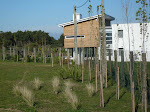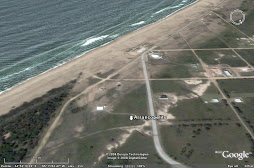The September 17 issue of Forbes Life has the following article on Punta del Este, mentioning marabierto.Uruguay
José Ignacio: Colonized in the '50s by Euro pacesetters like Yves Montand, Jeanne Moreau and Anita Ekberg, the Uruguayan peninsula of Punta del Este was recast as the South American Riviera. Fifty years later, as arguably the continent's toniest resort, this jet-set playground makes
South Beach feel about as chic as Jacksonville, its glittering December to February high season drawing such boldface names as Naomi Campbell, Mario Testino and Ralph Lauren.
But chic being inverse to popularity, the boldface names have now drifted east of the town of Punta del Este itself. Proceed up the two-lane coastal highway strung with glass-walled palazzi and such jaw-dropping luxe as architect Rafael Viñoly's futuristic $6-million-a-condo Acqua (check it out at www.acqua.com.uy). The haute habitués now sip their clerico -- a splendid regional concoction of white wine, Champagne and fresh berries--on the stretch of shore about 30 minutes away known as Brava Beach in the town of José Ignacio. Anchored by a landmark lighthouse, this wealthy enclave of private villas is where novelist Martin Amis and chic hotelier Alan Faena keep their holiday homes.
A seaside crescent of low, rolling dunes, rustling beach grass and whitecapped surf, José Ignacio is centered on an eccentric assortment of villas. Its pastiche of architectural styles, brightly painted modernist clapboard, whitewashed adobe, even classic Tudor, is a testament to the locale's capricious sequence of design vogues.
Just a few years ago a stay here meant being invited as a guest to one of the recherché beach community's private villas. Luckily for today's stylish interlopers, a handful of small, modish guesthouses have recently cropped up. The 12-room adobe-style La Posada del Faro, with its antique-scattered rooms, is Gisele Bündchen's choice. Nearby, Posada Azul Marino offers nine rooms in a modernist building overlooking a sand dune, while the airy Arbol is centered on a lush courtyard. At Posada de Piedra, six well-appointed suites are run by a former Buenos Aires fashionista.
"Foreign money is pouring in," says Margarita Palatnik, sitting pretty in her international design emporium, Marabierto, in nearby La Barra. "We've been 'discovered'...." Foreign buyers are snapping up property and villas at such a clip up and down the peninsula that Europeans and Americans now comprise 15 to 20 percent of Marabierto's business, and Sotheby's International has opened a realty office in Punta. Four years ago, the clientele was almost exclusively the wealthy South Americans who traditionally summer here. "Needless to say," adds Palatnik, "we're delighted."
In José Ignacio, which a few years ago offered only a single fashionable restaurant, international discovery is partially fueling the launch of such hot spots as La Huella. An alfresco bar-restaurant on the Playa Brava, La Huella is a place where two o'clock luncheons erupt into a blur of bikinis and bottle service. Likewise, Marismo, another fashiony boîte a few minutes inland, sees models--and the inevitable paparazzi--crowding the dirt road out front during high season.
The place that started it all, the restaurant Los Negros, is a wonderfully romantic spot perched on a low cliff above the Atlantic. It has become as familiar a fixture in José Ignacio as the lighthouse it overlooks. Yet Francis Mallman, the prescient Argentine restaurateur who opened its tomato-red doors in 1992, arches a reflective eyebrow at the bustling, celebrity-splashed wave that has engulfed his once-solitary gourmet outpost. He is already moving on.
An elegant, silver-maned gentleman in his 50s, Mallman has auxiliary addresses including 1884, the most charming restaurant in Mendoza, gateway to Argentina's wine country, as well as the intimate 12-seat Buenos Aires dining room Patagonia Sur. His particular élan is demonstrated in his having stocked Los Negros with a poetry library.
At lunch, as Mallman and I spoke, I made a valiant attempt at a cast-iron pan of beautifully roasted snapper and vegetables--a dish that might easily serve four--fired up in the mammoth kiln Mallman calls an oven. At the next table, a lithe young South American girl made quick, effortless work of a 12-ounce steak.
Awash in late-afternoon sun, the sea crashing beneath us, Mallman explained that his next project will be to head the restaurant at the newest incarnation of the Aman Resorts--owned Setai, due for a seaside 2008 debut here. But he is putting the picture-postcard Los Negros behind him. Work at the Setai aside, he is swapping José Ignacio's see-and-be-scene for the quiet charms of tiny Garzón, 40 minutes inland, a once bustling railway town with 2,000 residents that dwindled to its current 200 inhabitants when the train stopped coming. Is Mallman ahead of the curve yet again?
Thanks at least partly to him, the area surrounding Laguna Garzón is shaping up as Uruguay's nascent "Next Spot." Having remodeled Garzón's general store into an extremely chic five-room hotel called El Garzón, Mallman has equipped its restaurant with stoves that prepare dishes in an Andean style called "infiernillo"--"little Hell"--meaning cooked on iron griddles between two wood fires and brought to the table sizzling. He has now opened a café off the square, refinished another building into a charming concert hall and bought up surrounding pueblos to refashion as private villas. While still under the radar, it's a cinch bet that by 2010 you'll be reading about the "glittering guests of Garzón...." --Viia Beaumanis


No comments:
Post a Comment